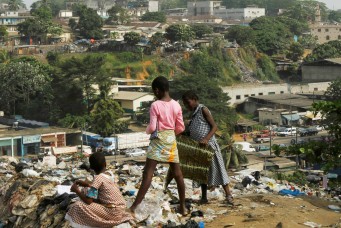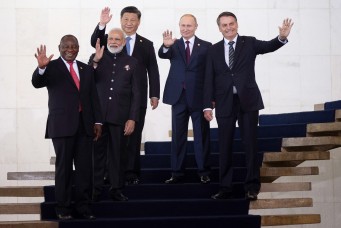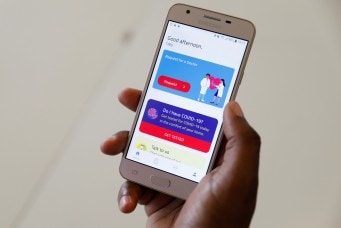Africa and the United States: Reengaging with Africa’s Prosperity in Mind
With China as a dominant foreign power in Africa, the only option left for United States to engage with the continent is to follow its priorities: namely, prioritizing African youth.

Since 1981, every American administration has had an African policy. Through “constructive engagement,” President Reagan heavily influenced the Southern African political scene. President George H.W. Bush worked to end the civil wars in east and southern Africa. President Clinton’s signature investment mechanism under the African Growth and Opportunity Act (AGOA) focused on trade toward the U.S. market. His successor, President George W. Bush, initiated the President’s Emergency Plan for AIDS Relief (PEPFAR), and the Millennium Challenge Corporation made gains in improving infrastructure. President Barack Obama’s Power Africa, Feed the Future, and the Young African Leaders Initiative (YALI) are supplemental to all these past initiatives. Though they focus on Africa, the policies from this one country toward the fifty-four African countries bear a thread of consistency and predictability.
Former President Trump’s “America First” strategy did not end these initiatives. It continued to look at the African continent, legitimately, through American interests. In itself, this is not a problem because it provides Africa with an opportunity to rethink the development aid model. All major economies of the world have an Africa strategy. Each one of them wants to go faster in this race to have a piece of the African opportunity. They come alone with their plans, promising a better future for Africans.
In contrast, the African Continental Free Trade Area (AfCFTA) symbolizes “Africa First:” we want to prioritize our fellow Africans first, while others may choose to work with us after. For the continent to implement an Africa First strategy, it means understanding our own trajectory in an evolving multi-stakeholder environment. Africa First holds the potential for prosperity through innovation. Innovation gives us an opportunity to build with what we have. It allows us to learn from others while keeping the essence of who we are. But, we know that the continent must go farther than it has to date.
AIDS and Ebola
PEPFAR, since its launch in 2003, remains the largest commitment by any nation to address a single disease. By leveraging public resources, private sector organizations have been able to use science to advance the quality of treatment available to Africans and others who need life saving treatment. For eighteen years now, more than $85 billion has been invested in the global HIV/AIDS response. Yet, the lives saved are not necessarily enough to enable prosperity in Africa. The reality is that other health issues erode the gains made from vertical programs. Though health systems are part of the change and will help us capitalize on our human capital, diseases and viruses dominate systems’ capacity to respond on the continent. Thus, it is our responsibility as Africans to be clear about how we might preserve the lives saved for the work ahead.
When Ebola hit West Africa in 2014, the United States of America led a coalition of fifty countries to end the disease for good: and it worked. That coalition focused on local leadership, regional coalitions, and continent-led efforts to strengthen health systems, prioritizing three countries. A total of $5.4 billion was allocated by the U.S. government to Ebola response. One of Africa’s greatest contributions was to dispatch African health workers to Guinea, Liberia, and Sierra Leone, thus limiting the economic impact on the three countries representing 0.68 percent of Africa’s gross domestic product (GDP).
These engagements demonstrate a clear U.S. interest in African health matters. But, they also reflect the power of innovation and market-creating mechanisms that ensure pharmaceutical companies’ contribution to its GDP. While health emergency responses are important, they are the blind side of poverty alleviation programs. Diseases and viruses hit at weak infrastructure, thus leaving people unprepared and unable to climb the steep hill of recovery.
So, reengaging Africa means that health and economics must be part of the same discussion. If anything, COVID-19 reinforced that point.
Continental Prerequisites
The COVID-19 pandemic presents a renewed opportunity to enable prosperity in Africa. Health is a fundamental human right that enables societal productivity. The U.S. government continues to invest in health in Africa with significant resources through bilateral and multilateral mechanisms. While these are important, a good part of those funds are used for pharmaceutical and health products that are not produced on the African continent. As such, engaging Africa to resolve its health issues implies significantly reducing Africa’s annual pharmaceutical bill of $14 billion. The real opportunity lies in making young Africa work, as this industry holds the potential to create sixteen million jobs according to the Economic Commission for Africa.
Creating jobs for the continent requires an agile education system. Education, for my generation, meant a university degree in order to access a certain kind of job. It limited the manual and creative elements that have sustained other parts of the world. As such, Africa’s education system will benefit from the same boost that the U.S. economy received when “free” (i.e. tax-paid) public education was made available during the transition from agriculture to manufacturing. Education supported the economic transformation that enabled prosperity in America: if that trend holds true, African education should sustain African prosperity as well. Our education needs its coming of age in the era of economic transformation.
The generation in power must resolve the challenges that Africa’s youth face in keeping both health and education in check in order to fully benefit from the potential that our young population represents. And, we cannot approach these sectors separately. They are catalysts for the African youth’s need for market-creating environments on the continent. AfCFTA, a market of 1.3 billion people, needs decent jobs for its youth. However, without health and education, Africa’s youth reservoir remains a data point in the realm of possibilities.
Innovation: May Tomorrow Find Us Farther Than Today
The African continent bursts with its youth’s creativity, from the informal sector to the tech savvy: all entrepreneurs in their fields. Any local, regional, or global policies that miss their needs and aspirations are bound to fail. In this respect, there are four areas that matter to Africans for the United States of America to reengage Africa.
Agriculture
Agricultural transformation in the United States of America limited the impact of chronic malnutrition and hunger and enabled economic progress in the country. Agriculture is especially useful in its potential to provide jobs for workers with low-level skills who spend most of their income on food. We know that planned agricultural transformation in Brazil, China, and Vietnam created jobs, raised incomes, and fostered the conditions for the workforce to move gradually into higher-value economic activities. China succeeded in its agricultural transformation and thus opened the pathway for added value-chain opportunities twenty years down the line.
The first priority for African agriculture will be to meet modern tools and techniques. That is not a problem for the United States of America to resolve; rather, African citizens should value the contribution of rural Africa to their urban transformation. We know that the most effective way to transform a country or a continent is by supporting agriculture. And in our context, like in other parts of the world, we need to redesign the economy so that modern farming techniques do not just adapt to climate change, but ignite the flame of sustainable transformation.
We know that growth from commodity extraction and trading, for instance, does not redistribute wealth nor enable prosperity for the majority. The value addition that it might be able to create is exported and exacerbates rent-seeking behavior from urban elites. So the relationship between the United States of America and Africa will benefit from higher value engagement when Africans transform their agriculture without limiting their scope to the AGOA. For example, agriculture in Africa must start to reflect the needs of its population to avert the impact of lifestyle diseases, such as diabetes, on its urban and rural populations. Yet, Africa’s food import bill is predicted to rise to $110 billion annually by 2025, from $35.4 billion in 2015; this means that African farmers, especially women, are not moving up the value chain.
Manufacturing
One way to accelerate this process is to move up the value chain and create a greater interest for young people to enter with their creativity. In Tunisia, agriculture represents about 11 percent of GDP and 15 percent of employment. The country counts ninety-two thousand engineers, with about ten thousand of these unemployed. Through modernization and addressing climate change, incentives can be created for youth along the value chain of agriculture, which will inevitably progress into light manufacturing. That transformation will capture the spending of those that need to eat at low cost. In Nigeria, for example, making noodles ensures that local skills and local context meet the demands of those who make some parts of the economy grow: informal workers.
A coordinated effort by African citizens to demand better conditions for their fellow citizens by consuming and purchasing local output is also essential. We cannot continue to wish for better local content when we continue to import most of our items from outside the African continent. This is also a local prerogative; certainly, the United States of America is not, necessarily, responsible for our individual consumption choices when we are 1.3 billion people.
Market-creating innovations transform complicated and expensive products into products that are simple and affordable, making them accessible to many more people who historically couldn’t afford them. Innovation requires us to look at our resources under AfCFTA and invest in what is required to produce, with greener energy, what the fifty-four African countries need. Leverage will come from the infrastructure required to move people, goods, and services through the continent, from Lesotho to Cape Verde.
Industrialization
The Coronavirus pandemic demonstrated that Africa cannot rely on global supply chains to absorb its raw materials. Industrialization is a process: it requires a number of ingredients, most importantly energy. In the absence of energy, the other elements find it hard to connect and add value. In this context, the Power Africa initiative by the United States Agency for International Development is helping to turn more lights on and transform lives by providing first-time access to electricity for 14.8 million new home and business connections. And, because Africa is a latecomer, our industrialization should be green. In this respect, renewable energy presents a real opportunity for Africa to create jobs in energy generation and in the supply chain required to move products across the continent. Just like the engagement seen in AIDS and Ebola, energy must have a purpose: and that purpose is industrialization.
Trade
Trade is about people making informed decisions about their comparative advantage. That is a critical, yet understated, element of the future of the United States of America–Africa relationship. The model of development that some African leaders are implementing reflects, in part, their own engagement with the West when they were students or workers. But, with China’s growing influences in the continent, Africa’s present and future will have an eastern flavor.
The AGOA did not take the continent to a point where trade transformed lives at scale. In fact, recent data demonstrates that China is the main African trading partner. This means that young people may increasingly engage with China for work, and that the African informal sector, through trade of imported goods and services, is looking East. Opportunities to learn will determine the nature of the Africa–China relationship for the next generation of leaders; unlike my generation, the number of African students in China increased twenty-fold since 2005. One of the key implications of this is that future African decision-makers will have the benefit of having experienced the impact of large-scale growth, agricultural transformation, manufacturing and industrialization: an invaluable experience, also changing the nature of young Africans’ relationship to the United States of America.
Part of the draw of China stems from a realization among Africans that alternatives exist to the United States of America. Young Africans see that China escaped the poverty trap through homegrown solutions that focused on value addition and global value chains while emphasizing domestic transformation. They have seen how “Made in China” transforms the lives of millions of people, from agriculture to industrialization. Having observed that transformation, it is unlikely that young Africans will look west of the Sahara only.
U.S. Reengagement with Africa: The Way Forward
Any policy engagement which does not think of Africa as a whole will have a limited impact. PEPFAR demonstrated the impact of a coordinated response to fight AIDS in Africa. The new administration can learn from the health response to leverage the Africa First strategy embedded in the AfCFTA. Working through AfCFTA starts with agriculture to enable, with us, prosperity in rural communities first. As that happens, achieving prosperity for the whole of society requires youth to work, create work, and step onto the bandwagon of prosperity. In addition, it is our responsibility to seek unity in African relationships with foreign countries where the temptation to accept fifty-four different agreements is real. Though it appears easier to do it alone, universal issues like youth migration demonstrate that we need to do it together, as only unity will make the 1.3 billion-person market work for Africa and its partners.
Africa’s youth have a clearer sense of what they aspire to for themselves and the continent. As such, urban and rural youths have their role to play in becoming actors of development of the continent based on their own accurate understanding of continental policies. Many understand that it is better to enable prosperity, and this is what the Chinese dream invokes. The American dream will remain, but will no longer be the preferred narrative on the African continent.
It is clear that U.S. reengagement with Africa has to be seen and implemented through the lens of the continent’s youth. The YALI initiative gave young Africans a framework to engage, but its real value would have been to invest in learning institutions on the continent so that young Africans could deepen their own understanding of who they are in relation to their peers.
The policies of the past forty years intended to move the cursor of development toward full capacity. Yet, political upheavals on the continent and the changing U.S. political landscape have not been consistent in delivering on what matters to young people: decent jobs. By navigating the sociopolitical challenges of the continent, we may not have been able to take full advantage of the economic offers that were made available.
In reality, it is political. In essence, it is financial. Yet, in the end, it should be human. A human-centered reengagment means that we must start with what we already have in Africa: an abundant youth with aspirations for the world embedded in the informal economy that we have today. We can: and the world’s future depends on our ability to put Africa first.
Carl Manlan works at the intersection of public, private, and civil society sectors at Ecobank Foundation in Lomé, Togo. He is a graduate of Harvard Kennedy School and the author of numerous articles on African economic transformation. On Twitter: @CarlManlan.
Read MoreSubscribe to Our Newsletter





